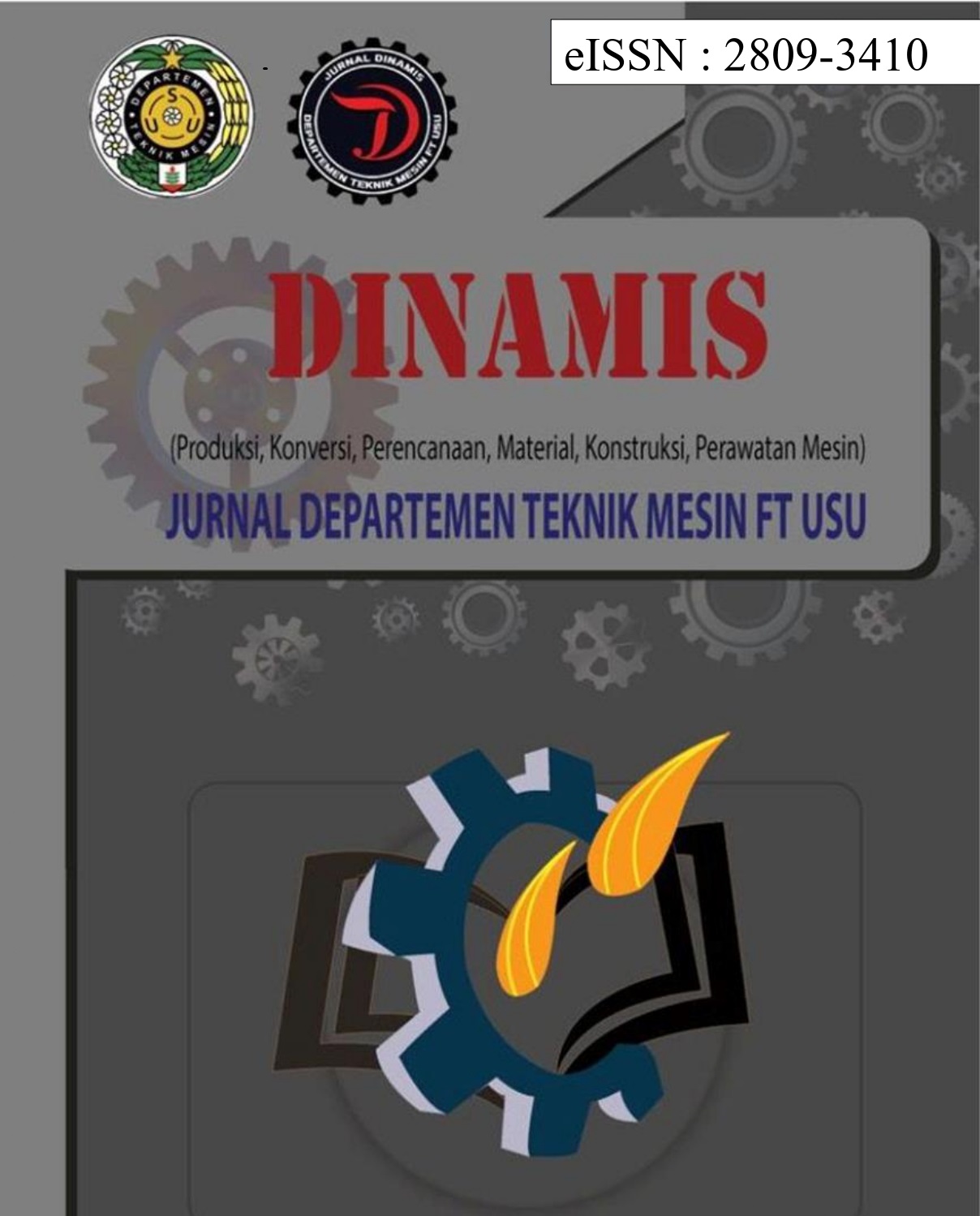Numerical Study of Orifice Plate in Entrance and Fully-Developed Flow Region for Fluid Flow Measurement
DOI:
https://doi.org/10.32734/dinamis.v13i1.21558Keywords:
orifice plate, fluid flow, computational fluid dynamics, entrance region, fully-developed flow regionAbstract
Having reliable data is important for analyzing the fluid behaviour inside the pipe. Hence, the selection of the fluid flow measurement instrument becomes critical to fulfill its objectives. Orifice plate, one of the pressure-based device is commonly used for its simplicity and ease of use. One of the phenomena that occurs during the flow measurement process using an orifice plate is the pressure drop between its upstream and downstream regions. Many researchers have brought this topic to find the best solution to reduce the pressure drop impacts to fluid flow for both experimental and numerical analysis. Understanding the pressure drop situation of the orifice plate in the entrance region and fully-developed flow region remains a relatively unanimous topic. A numerical study is conducted on this research to find the influence of the orifice plate’s thickness and the location of the installation of the orifice plate on the fluid flow to the pressure difference in the upstream and downstream sides of the orifice plate. The results show that the pressure drop at its highest will happen when a thicker orifice plate is chosen and it is located in the entrance region. This result will hopefully give better insight for orifice plate research in order to reduce pressure drop in fluid flow, which could ultimately increase the efficiency of the process of fluid flow inside the pipe. Future work can be expanded to study the orifice plate’s mechanical behaviour due to pressure from fluid flow.
Downloads
References
[2] M. Đurđević, M. Bukurov, S. Tašin, and S. Bikić, “Experimental research of single-hole and multi-hole orifice gas flow meters,” Flow Measurement and Instrumentation, vol. 70, p. 101650, Dec. 2019, doi: 10.1016/j.flowmeasinst.2019.101650..
[3] S. Vemulapalli and S. K. Venkata, “Parametric analysis of orifice plates on measurement of flow: A review,” Ain Shams Engineering Journal, vol. 13, no. 3, p. 101639, May 2022, doi: 10.1016/j.asej.2021.11.008.
[4] A. Zeghloul, A. Azzi, A. Hasan, and B. J. Azzopardi, “Behavior and pressure drop of an upwardly two-phase flow through multi-hole orifices,” Proceedings of the Institution of Mechanical Engineers, Part C: Journal of Mechanical Engineering Science, vol. 232, no. 18, pp. 3281–3299, Oct. 2017, doi: 10.1177/0954406217736081.
[5] “Power Plant Instrumentation and Control Handbook.” Elsevier, 2015. doi: 10.1016/c2013-0-18887-3.
[6] M. Đurđević, M. Bukurov, S. Tašin, and S. Bikić, (“Numerical Study of Single-Hole and Multi-Holes Orifice Flow Parameters,” JAFM, vol. 14, no. 01, Jan. 2021, doi: 10.47176/jafm.14.01.31472..
[7] A. Golijanek-Jędrzejczyk, A. Mrowiec, R. Hanus, M. Zych, M. Heronimczak, and D. Świsulski, “The assessment of metrological properties of segmental orifice based on simulations and experiments,” Measurement, vol. 181. Elsevier BV, p. 109601, Aug. 2021. doi: 10.1016/j.measurement.2021.109601.
[8] A. S. Morris and R. Langari, “Flow measurement,” Measurement and Instrumentation. Elsevier, pp. 499–534, 2021. doi: 10.1016/b978-0-12-817141-7.00016-5.
[9] T. Hariguru and S. Srinivasan, “The Effect of Differential Pressure and Permanent Pressure Loss on Multi-Hole Orifice Plate,” Measurement Science Review, vol. 23, no. 5, pp. 227–236, Oct. 2023, doi: 10.2478/msr-2023-0029.
[10] B. Gulsacan, N. Tokgoz, E. S. Karakas, M. Aureli, and C. A. Evrensel, “Effect of orifice thickness-to-diameter ratio on turbulent orifice flow: An experimental and numerical investigation,” International Communications in Heat and Mass Transfer, vol. 151, p. 107213, Feb. 2024, doi: 10.1016/j.icheatmasstransfer.2023.107213.
[11] Y. Ma, Y. Ma, J. Lyu, and W. Liu, “Wet gas pressure drop across multi-orifice plate in horizontal pipe in low gas-phase Froude number region,” Journal of the Taiwan Institute of Chemical Engineers, vol. 127, pp. 92–101, Oct. 2021, doi: 10.1016/j.jtice.2021.08.019.
[12] J. A. Barros Filho, A. A. C. Santos, M. A. Navarro, and E. Jordão, “Effect of chamfer geometry on the pressure drop of perforated plates with thin orifices,” Nuclear Engineering and Design, vol. 284, pp. 74–79, Apr. 2015, doi: 10.1016/j.nucengdes.2014.12.009.
[13] C. R. Mali, A. W. Patwardhan, G. K. Pandey, I. Banerjee, and V. Vinod, “CFD study on the effect of various geometrical parameters of honeycomb type orifices on pressure drop and cavitation characteristics,” Nuclear Engineering and Design, vol. 370, p. 110880, Dec. 2020, doi: 10.1016/j.nucengdes.2020.110880.
[14] Q. Li, C. Zong, F. Liu, T. Xue, A. Zhang, and X. Song, “Numerical and experimental analysis of the cavitation characteristics of orifice plates under high-pressure conditions based on a modified cavitation model,” International Journal of Heat and Mass Transfer, vol. 203, p. 123782, Apr. 2023, doi: 10.1016/j.ijheatmasstransfer.2022.123782.
[15] H. Düz, “Experimental and numerical optimization of orifice entrance conical geometry in a multi-hole plate to reduce the plate pressure loss,” European Journal of Mechanics - B/Fluids, vol. 114, p. 204287, Nov. 2025, doi: 10.1016/j.euromechflu.2025.204287.
[16] G. Chinello, “Orifice plates pressure loss – An improved theoretical equation for incompressible flow,” Measurement, vol. 246, p. 116687, Mar. 2025, doi: 10.1016/j.measurement.2025.116687.
[17] A. Akhyan and F. Fadhli, “Pengaruh Variasi Tebal Orifice dan Bilangan Reynolds (Re) terhadap Penurunan Tekanan (Pressure Drop) pada Entrance Region,” JQT, vol. 4, no. 2, pp. 75–82, May 2023, doi: 10.18196/jqt.v4i2.16154.
[18] A. Akhyan and Mhd. Arviansyah, “Pengaruh Variasi Tebal Orifice Lubang Tunggal Terhadap Pressure Drop dan Discharge Coefficient Pada Daerah Entrance dan Fully Developed,” Turbo, vol. 12, no. 2, Dec. 2023, doi: 10.24127/trb.v12i2.2235.
[19] G. Scott and P. Richardson, “The application of computational fluid dynamics in the food industry,” Trends in Food Science & Technology, vol. 8, no. 4, pp. 119–124, Apr. 1997, doi: 10.1016/s0924-2244(97)01028-5.
[20] [1] G. Tryggvason, “Computational Fluid Dynamics,” Fluid Mechanics. Elsevier, pp. 227–291, 2016. doi: 10.1016/b978-0-12-405935-1.00006-x.
[21] “Newnes Engineering and Physical Science Pocket Book.” Elsevier, 1993. doi: 10.1016/c2013-0-06543-7.
[22] Fox, R. W., McDonald, A. T., & Pritchard, P. J. (2004). Introduction to Fluid Mechanics Sixth Edition. John Wiley & Sons.
[23] “Fluid Flow for Chemical Engineers.” Elsevier, 1995. doi: 10.1016/b978-0-340-61058-9.x5000-2.
[24] “Analysis and Design of Energy Geostructures.” Elsevier, 2020. doi: 10.1016/c2017-0-04166-6.
[25] “Fully Developed Internal Turbulent Flows in Ducts and Pipes,” Jun. 24, 2025. [Online]. Available: https://innovationspace.ansys.com/courses/wp-content/uploads/sites/5/2020/09/Lesson-2-Fully-Developed-Internal-Turbulent-Flows-in-Ducts-and-Pipes-Handout.pdf. [Accessed: Jun. 24, 2025].
Downloads
Published
Issue
Section
License
Copyright (c) 2025 DINAMIS

This work is licensed under a Creative Commons Attribution-ShareAlike 4.0 International License.

















